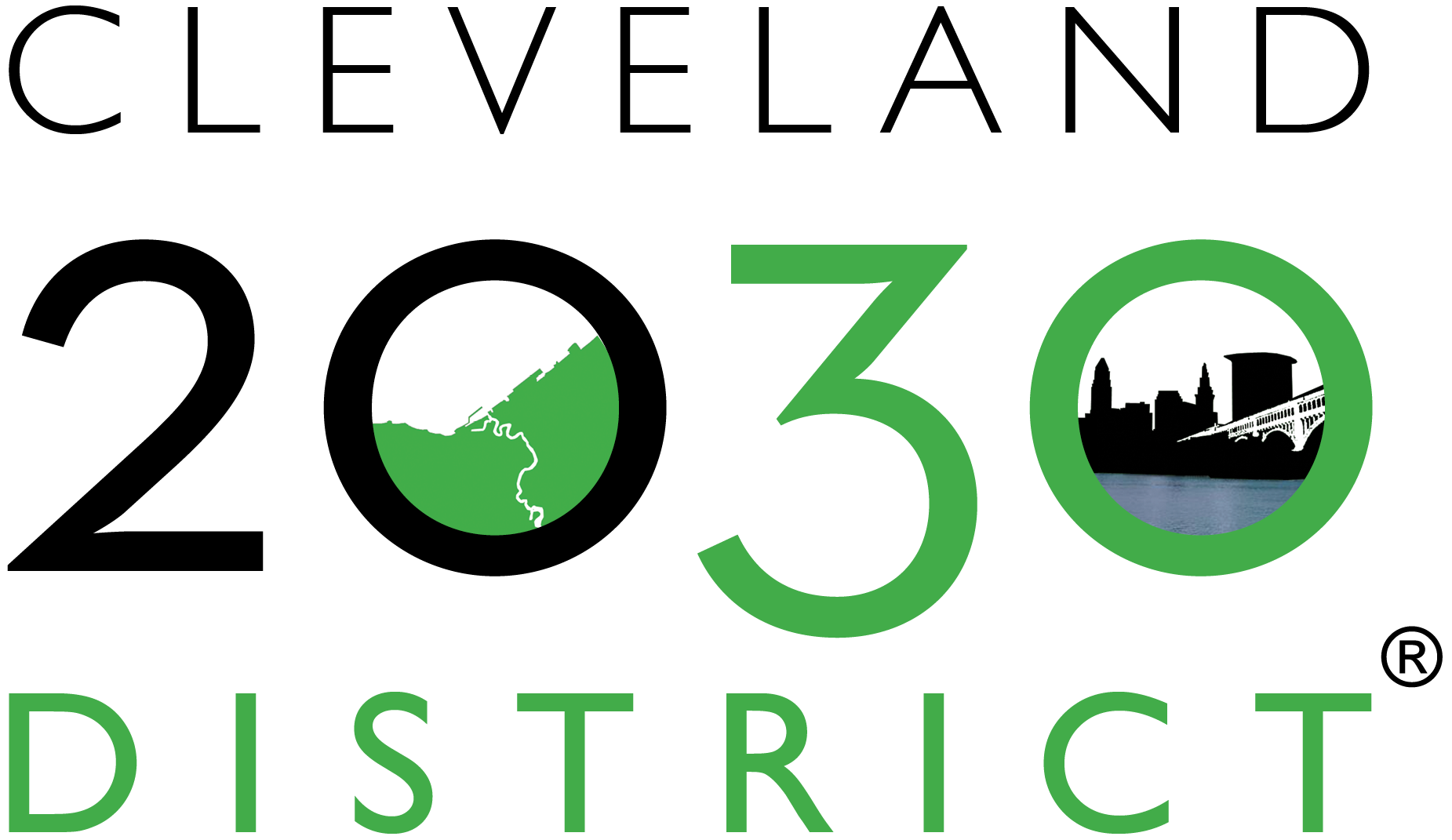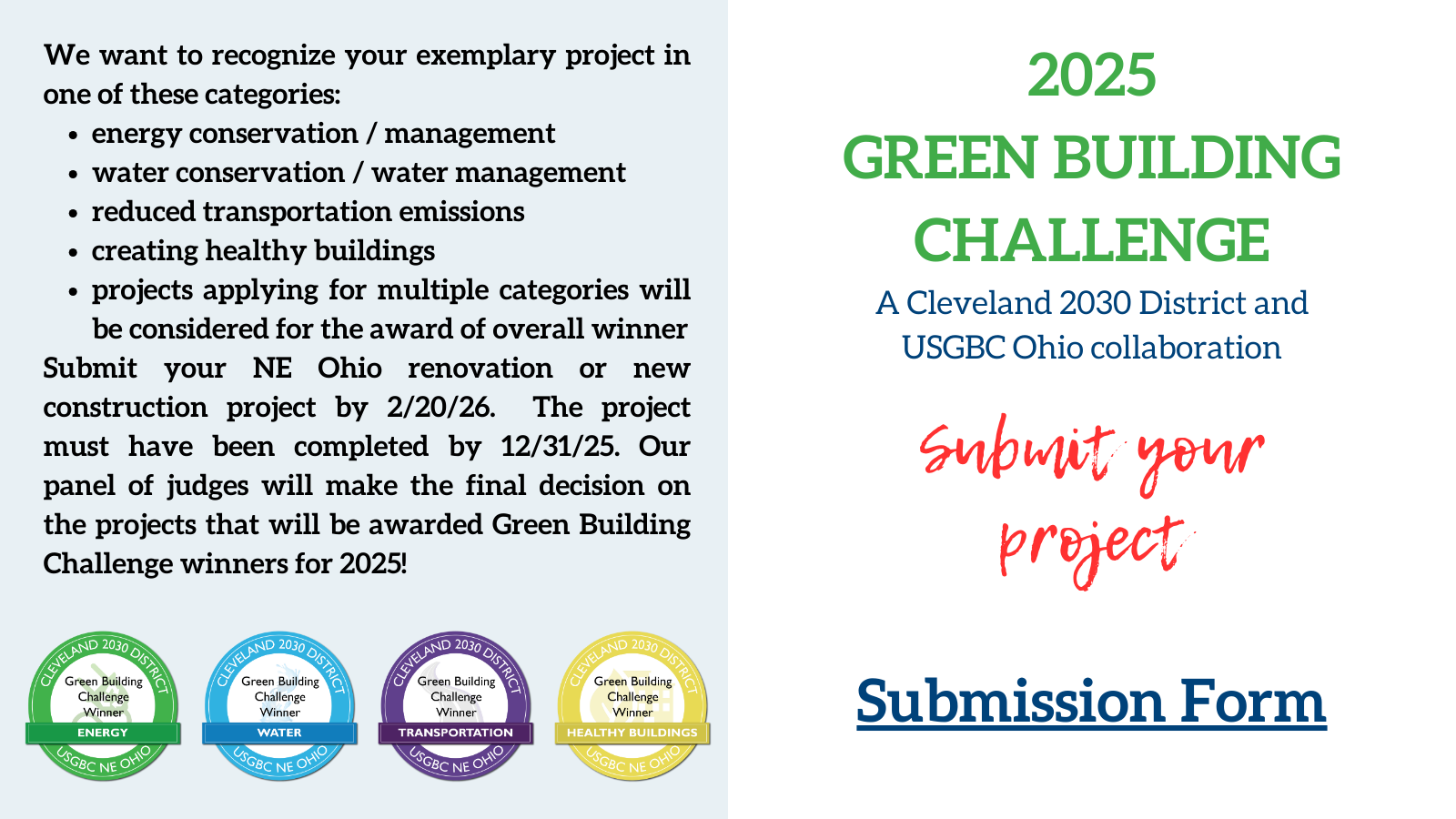Cleveland 2030 District and USGBC Ohio will partner again on our annual Green Building Challenge. Submit your exemplary project that saved energy, conserved or managed water, reduced transportation emissions, or created a healthy building environment.
- All retrofit, renovation or new construction projects in NE Ohio are eligible.
- Winners will be named in each of these categories: Energy Conservation, Water Management/Conservation, Reduced Transportation Emissions, and Healthy Buildings. You can submit a project for more than one category on a single application form to be considered for Overall Winner.
- If your project previously won for a specific category, it’s not eligible for that category this year, but can be submitted for a different category.
- If you previously entered a project that did not get recognized, you can resubmit it this year.
- The project must have been completed between January 2023 and December 2025.
- Submission deadline is February 20th.
- Winners will be recognized by: Cleveland 2030 District, USGBC Ohio, AIA Cleveland, ASHRAE Cleveland, through social media posts, newsletters, possible media publications, and an event to recognize winners.
- Daniella Kosareo, Director of Mechanical, Osborn Engineering
- Neeraja Pandav, Project Designer, Bowen
- Joshua Haney, Global Architecture Leader and Principal, DLR Group
- Rob Donaldson, AIA, NCARB, LEED AP BD+C, Fitwel Ambassador, Associate Principal, Project Manager, Moody Nolan
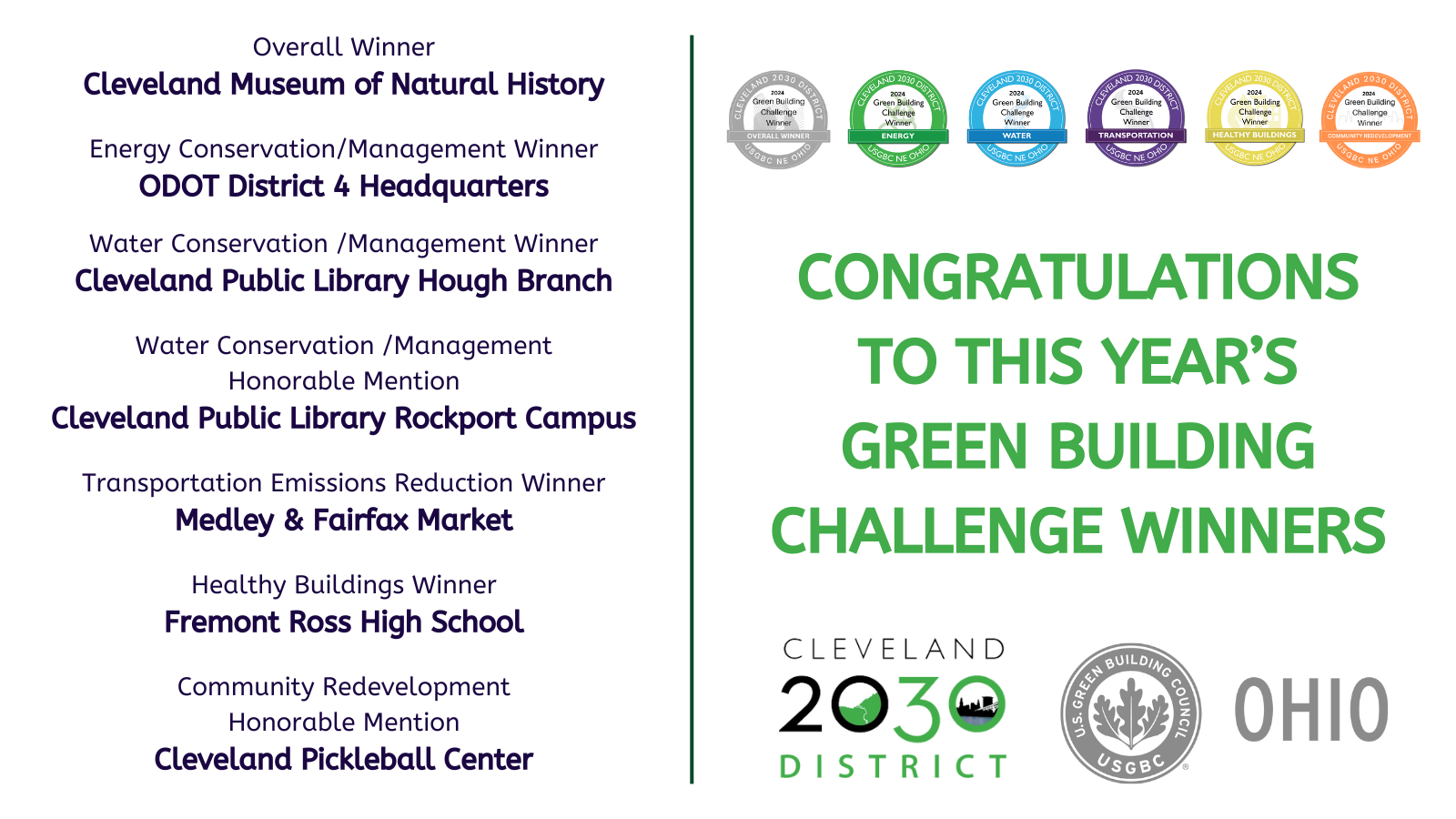
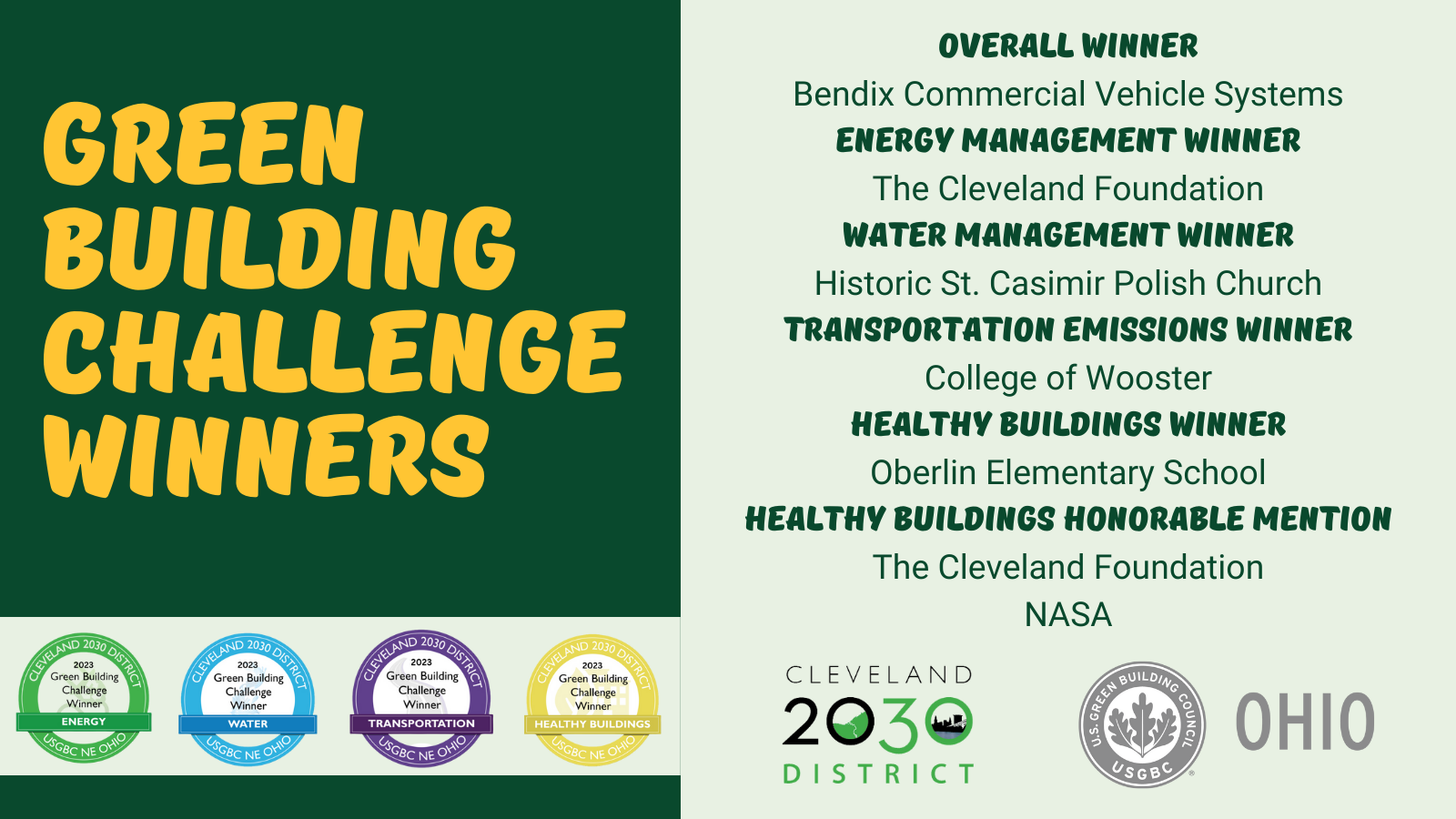
Green Building Challenge 2022
Cleveland 2030 District partners with USGBC Ohio Northeast Region to hold a friendly competition to recognize exemplary new construction and renovation projects in Northeast Ohio. Congratulations to all the winning projects.
See the details of the 2022 Green Building Challenge winning projects here:
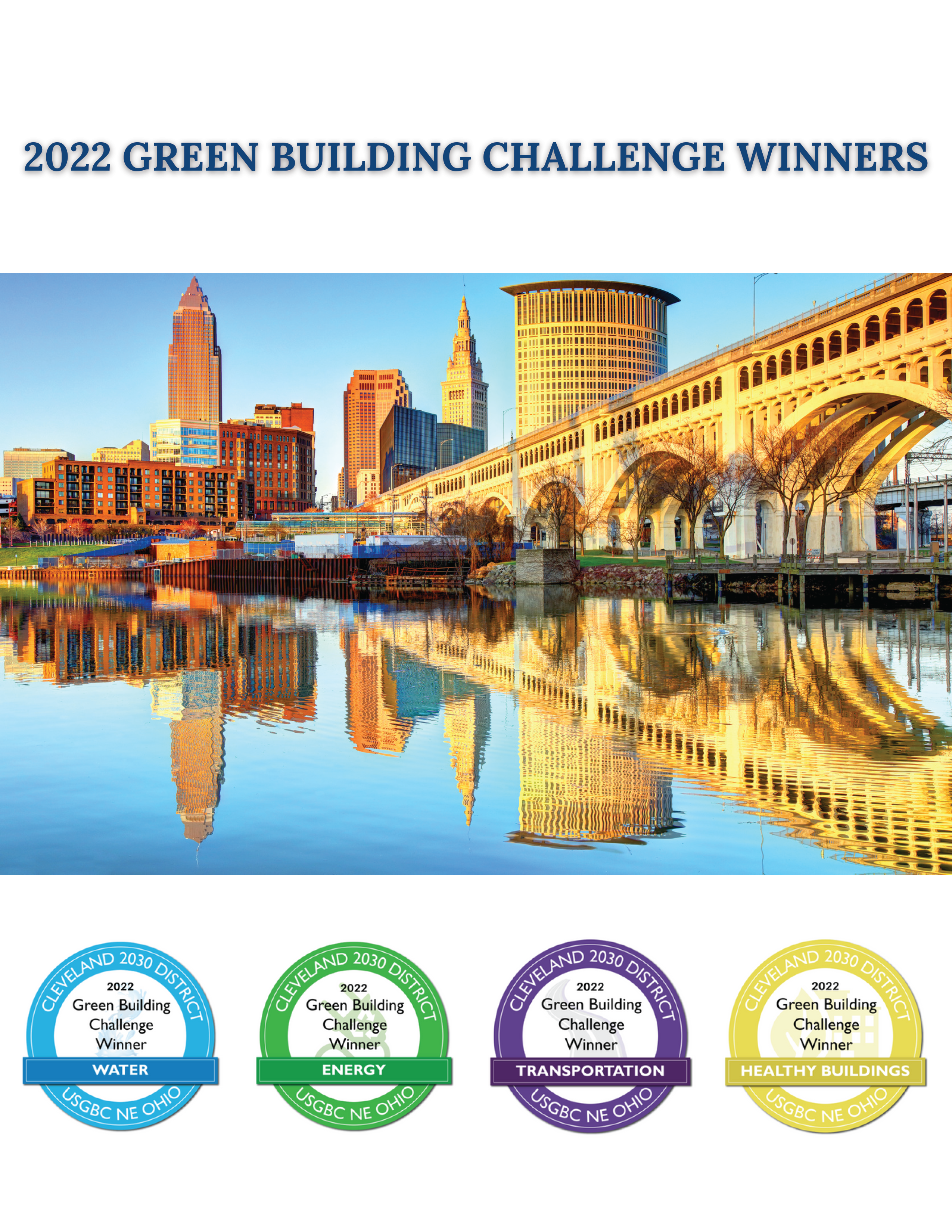
Green Building Challenge 2021
See details of winning Green Building Challenge projects here:
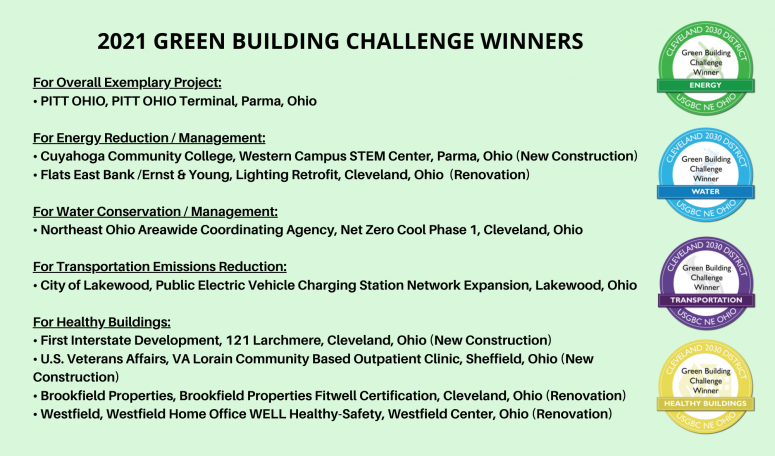
Green Building Challenge 2020
The Cleveland 2030 District holds an annual friendly Green Building Challenge in collaboration with USGBC Ohio, Northeast Region.
We use Energy Star Portfolio Manager (ESPM) to collect and analyze energy and water data. Originally, ESPM created the Energy Use Intensity (EUI is measured as kBtu/square foot/year) baseline using a 2003 Commercial Building Energy Consumption Survey. They updated baseline calculations using a 2012 survey. The 2030 Districts use ZeroTool to recreate the 2003 baseline to remain consistent in the challenge year over year.
The Water Use Intensity score (total water consumption/square foot/year) baseline is set by using the building’s own 2010 water use provided by Cleveland Water, or, in buildings built after 2010, we use their earliest full year of data.
We collect data from commuters in member buildings every other year. Our most recent transportation survey was at the end of 2020. Because of the pandemic, we collected monthly data to analyze its impact on commuting patterns and emissions. We measure baseline transportation emissions (CO2/commuter/year) using the 2001 National Household Travel Survey.
Since the pandemic affected buildings differently depending on use type and occupancy variables, we measured the challenge this year based on data through Q1 2020.
We measured reduction in EUI, WUI, and reduction in commuter transportation emissions, each in three categories:
Over 50% reduction from baseline
40-49% reduction from baseline
30-39% reduction from baseline
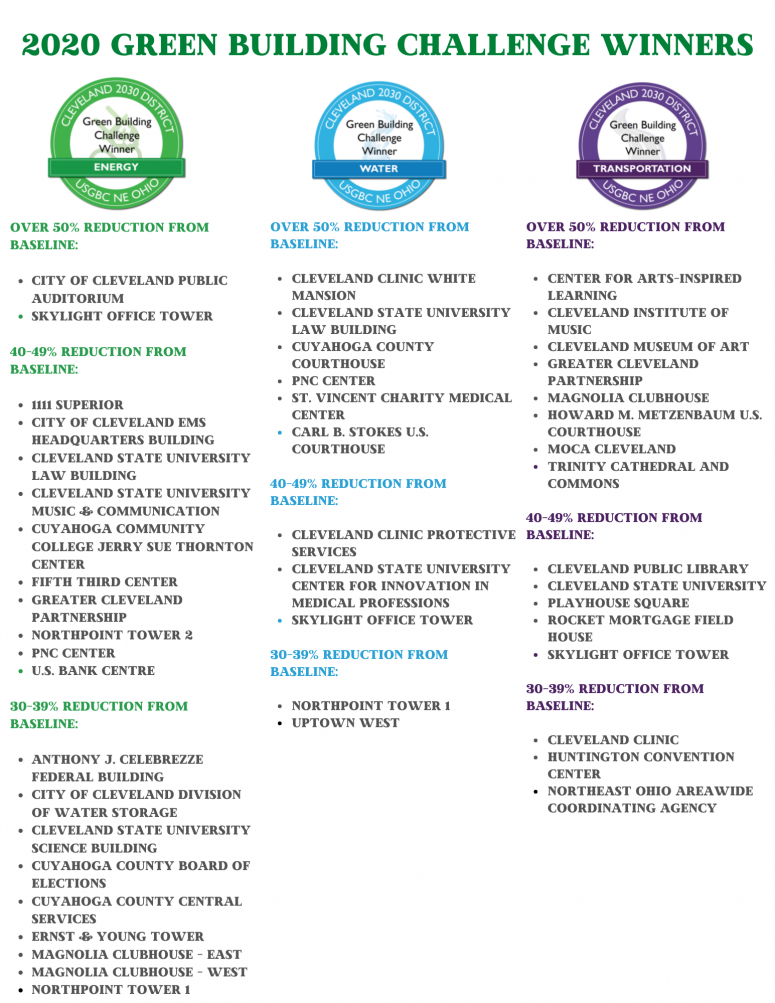
Green Building Challenge 2019
The Cleveland 2030 District holds an annual friendly Green Building Challenge in collaboration with USGBC Ohio, Northeast Region.
We use Energy Star Portfolio Manager (ESPM) to collect and analyze energy and water data. Originally, ESPM created the Energy Use Intensity (EUI is measured as kBtu/square foot/year) baseline using a 2003 Commercial Building Energy Consumption Survey. They recently updated baseline calculations using a 2012 survey. The 2030 Districts use ZeroTool to recreate the 2003 baseline to remain consistent in the challenge year over year.
The Water Use Intensity score (total water consumption/square foot/year) baseline is set by using the building’s own 2010 water use provided by Cleveland Water.
We collect data from commuters in member buildings every other year. Our most recent transportation survey was at the end of 2018. We measure baseline transportation emissions (CO2/commuter/year) using the 2001 National Household Travel Survey.
This year’s challenge measured reduction in EUI, WUI, and reduction in commuter transportation emissions, each in three categories:
30-39% reduction from baseline
40-49% reduction from baseline
Over 50% reduction from baseline
Congratulations to the 2019 Green Building Challenge winners:
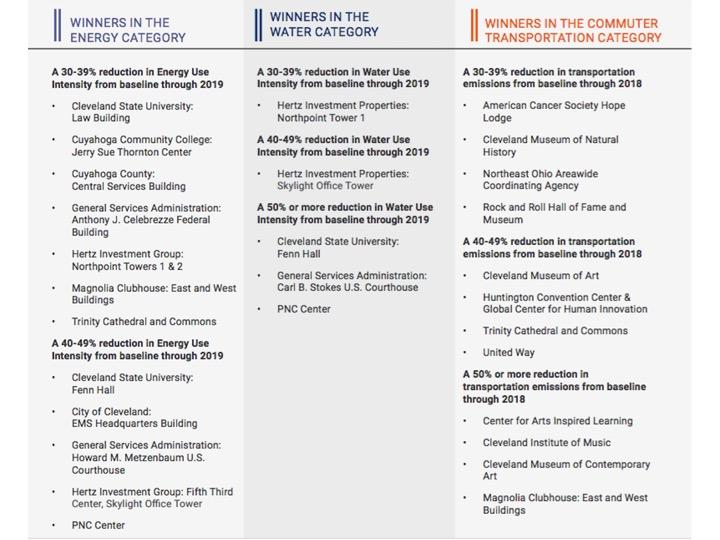
Green Building Challenge 2018
Cleveland 2030 District runs an annual friendly Green Building Challenge in partnership with USGBC Ohio Northeast Region. The Challenge has four categories:
- Most improved EUI (energy use intensity) from baseline through 2018
- Most improved EUI from 2017 to 2018
- Most improved WUI (water use intensity) from baseline through 2018
- Most improved WUI from 2017 to 2018
We use Energy Star Portfolio Manager (ESPM) to collect and analyze data. Originally, ESPM created the Energy Use Intensity (EUI is measured as kBtu/square foot/year) baseline using a 2003 Commercial Building Energy Consumption Survey. They recently updated baseline calculations using a 2012 survey. The 2030 Districts use ZeroTool to recreate the 2003 baseline to remain consistent in the challenge year over year.
The water use intensity score baseline is set by using the building’s own 2010 water use provided by the Cleveland Water.
Congratulations to the 2018 Green Building Challenge Winners:
Most improved EUI from baseline through 2018:
Winner: City of Cleveland, City Hall
2nd Place: PNC Center
3rd Place: 1111 Superior
Most improved EUI from 2017 to 2018:
Winner: K2M Design
2nd Place: Cleveland State University, Julka Hall
3rd Place: Cuyahoga Community College, District Office
Most improved WUI from baseline through 2018:
Winner: General Services Administration, Carl B. Stokes U.S. Courthouse
2nd Place: PNC Center
3rd Place: General Services Administration, Anthony J. Celebrezze Federal Building
Most improved WUI from 2017 to 2018:
Winner: Cleveland State University, Julka Hall
2nd Place: Calfee Building
3rd Place: General Services Administration, Carl B. Stokes U.S. Courthouse
Green Building Challenge 2017
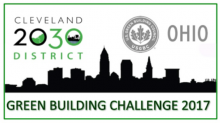
The Green Building Challenge is a friendly competition between buildings in Northeast Ohio, measuring reduction in energy consumption. Cleveland 2030 District has collaborated with USGBC Ohio Northeast Region for the past 4 years to present this event.
The Challenge measures progress in four categories:
Greatest reduction in Energy Use Intensity from baseline through 2017
Greatest reduction in Energy Use Intensity from 2016 to 2017
Greatest reduction in Water Use Intensity from baseline through 2017
Greatest reduction in Water Use Intensity from 2016 to 2017
Cleveland 2030 District calculates the winners by using Energy Star Portfolio Manager. The energy baseline is set by Portfolio Manager using a 2003 Commercial Building Energy Consumption Survey. The water baseline is set by using the building’s own 2010 water use provided by the Cleveland Department of Water.
We’re proud to announce our 2017 Green Building Challenge winners!
Greatest reduction in EUI from baseline through 2017:
Winner: United Way
Second Place: Metzenbaum Courthouse
Third Place: 1111 Superior
Greatest reduction in EUI from 2016 to 2017:
Winner: Cuyahoga Community College – District Office
Second Place: AM Higley
Third Place: Cuyahoga Community College – Jerry Sue Thornton Center
Greatest reduction in WUI from baseline through 2017:
Winner: Carl B. Stokes Courthouse
Second Place: Cleveland State University, Cleveland-Marshall College of Law Wolstein Hall
Third Place: Cleveland State University, Science Building
Greatest reduction in WUI from 2016 to 2017:
Winner: AM Higley
Second Place: Anthony Celebrezze Federal Building
Third Place: Cleveland State University, Science Building
Congratulations to all the winners of the 2017 Green Building Challenge!
Green Building Challenge 2016
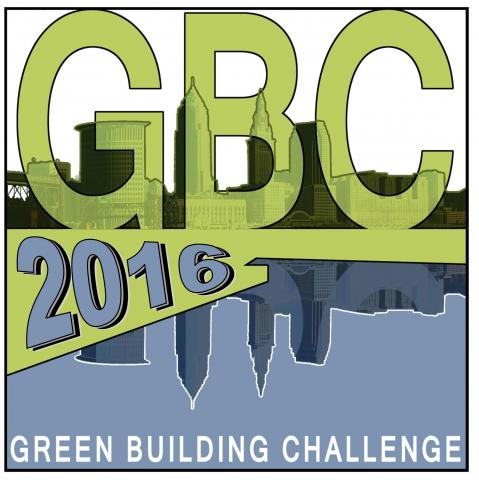
The Green Building Challenge is a friendly competition between buildings in Northeast Ohio which measures reduction in energy consumption. Cleveland 2030 District has collaborated with USGBC Ohio Northeast Region for the past 3 years to present this event.
Green Building Challenge 2015
The Green Building Challenge is a program of the Northeast Ohio Chapter of the United States Green Building Council and the Cleveland 2030 District.
A series of four educational events were presented throughout 2015 to educate building owners and operators on the benefits of green building practices. Cleveland 2030 District provided guidance on creating an Energy Star Portfolio Manager account to measure progress. The Green Building Challenge celebrates reductions in energy use compared to baseline in Northeast Ohio.
Property owners, property managers and developers enter utility data in Portfolio Manager for measurement and verification of energy savings against performance baselines. Energy Use Intensity scores were calculated and awards were presented in several categories to those who have achieved significant savings.
The educational series was structured on the overall process of optimizing building energy performance: evaluating facility performance (ASSESS), setting goals and creating an action plan (TARGET), implementation of energy conservation measures (DELIVER), and measurement/verification of savings (MEASURE).
Congratulations to the winners of the 2015 Green Building Challenge:
Greatest Reduction form Baseline EUI Through 2014:
Winner: United Way
Second Place: The Albert M. Higley Company
Third Place: Midtown Professional Building
Honorable Mention: K2M Design
Greatest Reduction from Baseline EUI Through 2015:
Winner: United Way
Second Place: The Albert M. Higley Company
Third Place: Midtown Professional Building
Honorable Mention: Cuyahoga Community College
Most Improved EUI 2014 to 2015:
Winner: Forest City Realty Trust Post Office Plaza
Second Place: Forest City Realty Trust Tower City
Third Place: United Way
Honorable Mention: Progressive Field
To read more about the 2015 Green Building Challenge, see the article in Properties Magazine, June 2016 edition.
Green Building Challenge 2014
The 2014 Green Building Challenge is a program of the Northeast Ohio Chapter of the United States Green Building Council presented in collaboration with the Cleveland 2030 District.
Presented as a series of four events throughout 2014, the Green Building Challenge educates building owners and operators on the benefits of green building practices, provides guidance on creating an ENERGY MANAGEMENT PROGRAM, and celebrates reductions in energy use related to past energy retrofit projects completed in Northeast Ohio.
Property owners, property managers and developers submit past projects for measurement and verification of energy savings against performance baselines, and awards will be given out in several categories to those who have achieved significant savings. Property owners, managers and developers who would like to learn about energy efficiency but do not wish to participate in the scored Challenge are also welcome to attend.
The entire series is structured on the overall process of optimizing building energy performance: evaluating facility performance (ASSESS), setting goals and creating an action plan (TARGET), implementation of energy conservation measures (DELIVER), and measurement/verification of savings (MEASURE). Each event will be focused on a different phase of the energy management program and will be held from 7:30a – 10:00a on the following dates, with breakfast and registration from 7:30a – 8:00a [click the date for event details]:
Download the following presentations:
ASSESS Presentation:
DELIVER Presentation:
MEASURE Presentations:
